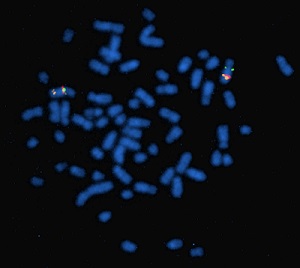Color is among some of the earliest traits we selected in newly domesticated species (1). Today, color can be critical for registration and therefore, the value, of our horses. For example, in breeds like the Friesian (which requires true black) and the exotic Mangalarga Marchador (which does not allow cremellos or perlinos) color is more than an aesthetic preference, it is a breed requirement. Indeed, on average, presence of a spotting pattern doubles the value of an American Paint Horse Association (APHA) foal. For example, in 2006, the average price of an APHA registered yearling without a spotting pattern was $1540, while a yearling APHA registered horse with the tobiano pattern averaged $2803 (2).
Breeding for Color
October 06, 2016
Posted by S.A. Brooks and L. Patterson-Rosa in Genetics
Can Genetics Turn the Art of Stallion Selection into a Science?
February 03, 2016
Posted by S.A. Brooks and L. Patterson-Rosa in Genetics
 The horse genome contains all the information required to direct the growth and function of a foal, from conception to death. This enormous “text” is organized into chromosomes, much like the volumes of an encyclopedia. The domesticated horse possesses 32 unique chromosomes, and most cells carry two copies of each chromosome for a total of 64. Gametes of course are the exception, carrying just one of each of the chromosome pairs to the future offspring. This article will discuss information about genotype vs. phenotype, genetic testing, and recent genetic studies performed on stallions.
The horse genome contains all the information required to direct the growth and function of a foal, from conception to death. This enormous “text” is organized into chromosomes, much like the volumes of an encyclopedia. The domesticated horse possesses 32 unique chromosomes, and most cells carry two copies of each chromosome for a total of 64. Gametes of course are the exception, carrying just one of each of the chromosome pairs to the future offspring. This article will discuss information about genotype vs. phenotype, genetic testing, and recent genetic studies performed on stallions.
Please Note - photos used in these news articles are available in the public domain, have been purchased through istockphoto or (when referencing breeders or horses) have been submitted to Select Breeders Services Inc. by the breeding farm or horse owner. Photo credit has been provided where applicable. If at anytime you see something that needs to be addressed please feel free to contact us directly.
- Categories
- Affiliate News
- Breeding with Frozen Semen
- Contract Considerations
- Disease and Health Testing
- Embryo Transfer
- Foal and Neonate Care
- Focus On Our Breeders
- Frozen Semen
- General Interest
- Genetics
- Guidelines
- Import and Export
- Industry News
- Mare Management
- Nutrition
- Stallion Management
- _Archived Articles
- Contributors
- Andrew Swenson
- Chad Mendell
- Clair Thunes, PhD
- Don Kapper
- Dr. Anna Toenissen
- Dr. Brian Carroll
- Dr. Carleigh Fedorka, PhD
- Dr. Clair Thunes
- Dr. Dave Scofield
- Dr. Ed Squires
- Dr. Ed Squires and Dr. Pat McCue
- Dr. Elena Martinez de Andino
- Dr. Erin Newkirk
- Dr. Gabe Young
- Dr. Glenn Blodgett
- Dr. Holly Mason
- Dr. Igor Canisso
- Dr. Jed McKinlay
- Dr. Jerry Longworth
- Dr. Jessica Quigg
- Dr. Karen Wolfsdorf
- Dr. Margo Macpherson
- Dr. Maria Schnobrich
- Dr. Nikki Collins
- Dr. Phil Matthews
- Dr. Regina Turner
- Dr. Richard Giacopuzzi
- Dr. Robert Franklin
- Dr. Ryan Ferris
- Dr. Sandro Barbacini
- Dr. Stephanie Walbornn
- Dr. Stuart Meyers
- Dr. Ute Pansegrau
- Erin Bishop
- Erin Bishop, MS
- Julie Fershtman
- Julie Skaife
- Karen Wolfsdorf, DVM Dipl ACT
- Karen Wolfsdorf, DVM, DACT
- Laura Patterson Rosa, DVM, Ph.D.
- MR Petersen and AM Bojesen
- Mallory Canaday
- Meredith Bonnell, MS
- Michelle Regan
- Natalie DeBerardinis
- Old Dominion Hemp
- Paul Loomis
- Quinnten Alston
- Rood and Riddle Equine Hospital
- S.A. Brooks and L. Patterson-Rosa
- SBS
- SBS-MD
- SBSI
- SBSW
- Recent Posts
- SBS Helps Safeguard Breeds from Extinction
- 2024 SBS Foal Photo Contest Winner
- Saving the Poitou Donkey
- Squires Awarded 2024 ISER Pioneer Award
- 2023 SBS Foal Photo Contest Winner
- Leah Lively: Her ICSI Journey
- International Symposium on Equine Reproduction – Dr. Ed Squires Recognized as Honorary Chair

